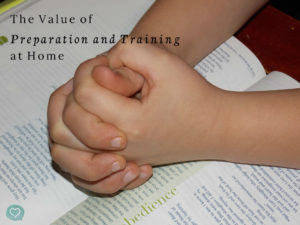 Here’s the scene: Dad takes 2-year-old twins to a public family bathroom for the girls to go potty while Mom is busy nursing the baby. While helping the second twin, he turns to check on the first one who was supposed to be waiting to wash her hands. What he sees may be an all-too-familiar sight – the paper towel roll that was low enough for her to reach is now flowing to the floor, piling up in a puddle at her feet and she is giggling with delight at her new found toy. Behaviors like this aren’t unusual with young children. What one toddler doesn’t think of, chances are, the other one will. But these parents have been working on self-control hands at home and quickly Dad calls out, “Evi, get your self-control hands,” using his voice of authority. What happens next confirms the promise he’d heard in our Toddlerhood Transitions class: if you will practice self-control hands during times of non-conflict at home, then during stressful times when your child is out of control, whether at home or in public, you can call her to your established standard and she knows what you are asking her to do. Evi stopped pulling the paper towel roll and put her hands together and smiled at Daddy. It was too cute! He pulled out his phone to snap a picture to share with me, “It works!” His doubts were erased by the evidence at hand. Small victories like this fuel parents’ determination and perseverance to continue with the hard work of training character in their children.
Here’s the scene: Dad takes 2-year-old twins to a public family bathroom for the girls to go potty while Mom is busy nursing the baby. While helping the second twin, he turns to check on the first one who was supposed to be waiting to wash her hands. What he sees may be an all-too-familiar sight – the paper towel roll that was low enough for her to reach is now flowing to the floor, piling up in a puddle at her feet and she is giggling with delight at her new found toy. Behaviors like this aren’t unusual with young children. What one toddler doesn’t think of, chances are, the other one will. But these parents have been working on self-control hands at home and quickly Dad calls out, “Evi, get your self-control hands,” using his voice of authority. What happens next confirms the promise he’d heard in our Toddlerhood Transitions class: if you will practice self-control hands during times of non-conflict at home, then during stressful times when your child is out of control, whether at home or in public, you can call her to your established standard and she knows what you are asking her to do. Evi stopped pulling the paper towel roll and put her hands together and smiled at Daddy. It was too cute! He pulled out his phone to snap a picture to share with me, “It works!” His doubts were erased by the evidence at hand. Small victories like this fuel parents’ determination and perseverance to continue with the hard work of training character in their children.
Self-control hands are a beautiful tool parents can use to diffuse the energy, curiosity, and lack of self-control of the toddler and preschool years. When children clasp their hands together and focus their gaze on their hands, the energy and emotion that flows from their hearts and minds begins to calm down. It works for adults too. Have you told your child to, “Calm down,” but he doesn’t understand what that looks like? Here is a way you can teach him:
Teach and train in times of non-conflict. Any training you want to do is best done at home and at times when your child is not in conflict with you. Wise parents realize the need for training before they need it, or more often, they see a misbehavior they don’t like and make a plan to train a virtue in its place. Maybe during a meal or after your child is finished eating, you can put his hands together and tell him, “These are self-control hands. Good job!” At first it may be only 3-5 seconds before he pulls away. Chances are you will need to lovingly cup your hands around his in the beginning. Praise his effort, even if he resists you. You are teaching him what “self-control hands” look like and your praise signals that this is a good thing.
The power of practice. Have you tried to teach your child a skill and decided it doesn’t work for your child? Let me encourage you to try again. Galatians 6:9 encourages us to “not become weary in doing good, for at the proper time we will reap a harvest if we do not give up.” While some children will easily submit to your attempts to establish boundaries in their lives, most will push back. All young children need time, practice, and our patience to become consistent at these skills. Practice self-control hands once or twice at meal time and then extend it to other times and places, like after a diaper change, in the grocery cart, during a story time, and more. Keep your voice pleasant and calm. In time, you will be able to ask him to show you his self-control hands and he will clap his hands together and smile – expecting your smiling face of approval and words of praise. What started as a few seconds grows to 15 – 30 seconds. All this is training time and practiced when the child is already calm. With deliberate practice, some toddlers and preschools can extend this skill to 5 minutes and more, but you don’t need that long to be able to use this skill like the dad above did.
Applying the skill in new situations. In time, you will be able to face your child’s emotions or misbehavior and use your words to call them to self-control. Now he knows what you mean! You’ve practiced it at home. He puts his hands together and looks at you. Your heart soars. It works! He is growing in self-control.
The power of praise. Praise him again for using his self-control hands, even if he is still whining or crying. If you need to, cup your hands around his and use a calm voice. Praise him again when he begins to calm down. Say something like, “Good job, you are getting your self-control.” Don’t expect perfection. This is a new skill and he will perfect it with practice. Consider that he is exercising a “muscle,” and practice and praise will cause it to grow. Your praise motivates him to keep doing something that is hard right now.
Your child’s self-control in public is a reflection of Christ’s character. We used to sing the children’s song, This Little Light of Mine. When we let our light shine, others can see Jesus, like in the young family in one of our classes. Another dad told me the story of their visit to the library shortly after teaching this skill at home. They were checking a stack of books out at the counter and his 2-year-old was trying to grab the books to put in his bag before the librarian was finished. Dad patiently directed his child to use his self-control hands and wait until the librarian was finished with the books. His child immediately put his hands together as they had been practicing at home and quietly waited. The librarian was impressed and praised the child and the father. This dad came back to class with new confidence that parenting is not a mystery, and he can teach his son valuable lessons. Do not despise the day of small beginnings (Zechariah 4:10) as you prepare and train your child at home. You can do it!
Beth Blunk is a Certified Contact Mom with Christian Family Heritage and along with her husband, Ed are Growing Families International leaders in Raymore, MO.





Leave a Reply